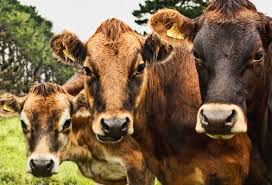
At the time, I was walking with my kind ex-husband around the perimeter of his small piece of rural paradise in Mahana which he’s planted entirely in trees, including sugar maples.
Our ramble began in deep tree-shade. Drifts of fallen leaves and pine needles crunched under our feet. Then, as we reached the back fence-line we stepped from shadow into sunlight and a bucolic landscape worthy of a Constable painting: a gently rolling patchwork of fields, small clusters of trees, the roofs of half-hidden houses and farm sheds, and tracks created by the movement of animals and humans over generations.
A small herd of young steers grazed in the neighbouring field. We paused taking in this appealingly domesticated landscape which, for us, included these handsome, sturdy animals. And then almost imperceptibly, the cattle stopped being simply part of the landscape ...

When I made what I hoped were suitably bovine noises, some of them jostled their way through the herd to continue their mild-eyed scrutiny at closer quarters.
When my husband and I set off again, they trampled through tall grass to walk beside us, until eventually a fence prevented them from going any further. Even then, they stood watching our departing backs.
I had begun the walk, as humans often unthinkingly do, unaware of how selfish and anthropocentric my view of the world actually is. But becoming an object of enquiry, the subject of the frank, inquisitive gaze of a large number of non-human mammals I realised how I usually think of myself as the observer, not the observed, the watcher not the watched.
This is true even though I should know better: I live with a dog who is keenly interested in what I do, or don’t do, and keeps me under close scrutiny even when her eyes are closed. She may be comatose in her basket but is instantly awake at the opening of the fridge door, or the chink of car keys. She even wakes up at the almost inaudible sound of walking shoes being laced up. Even more subtly, the dog often intuits that I will soon be going out, even before I myself, have quite formed the intention.
Anyone who lives with a pet, or works closely with animals or birds understands that animals watch us very closely and respond to our body-language and behaviours. Even so, it is so easy to slip into thinking of other living creatures simply as figures in the human landscape.
By coincidence, in the next week or two, I came across a piece by American essayist Annie Dillard describing an encounter with a weasel: “Our eyes locked, and someone threw away the key … as if two lovers, or two deadly enemies, met unexpectedly on an overgrown path when each had been thinking of something else.”
And then Eckhart Tolle commenting on human/animal relationships: “We are ultimately not separate, not from one another, nor from any living thing - the flower, the tree, the cat, the dog.”
 RSS Feed
RSS Feed

